The supplier contract management market stands at the threshold of a decade-long expansion trajectory that promises to reshape procurement operations and contract governance across enterprise organizations, supply chain management systems, and vendor relationship platforms worldwide. The supplier contract management market's journey from USD 1,850.9 million in 2025 to USD 3,959.1 million by 2035 represents substantial growth, demonstrating the accelerating adoption of digital contract management solutions and automated supplier oversight platforms across procurement departments, supply chain operators, and enterprise resource planning implementations.
The first half of the decade (2025-2030) will see the supplier contract management market increase from USD 1,850.9 million to approximately USD 2,707 million, adding USD 856.1 million in value, which constitutes 41% of the total forecasted growth period. This phase will be characterized by the rapid adoption of cloud-based contract management platforms, driven by increasing digital transformation initiatives and the growing need for automated supplier oversight solutions worldwide. Advanced analytics capabilities and AI-powered contract intelligence will become standard expectations rather than premium options.
The latter half (2030-2035) is expected to witness accelerated growth, increasing from USD 2,707 million to USD 3,959.1 million, representing an addition of USD 1,252.1 million, or 59%, of the decade's expansion. This period will be defined by mass market penetration of intelligent contract management technologies, integration with comprehensive supply chain platforms, and seamless compatibility with existing enterprise infrastructure. The supplier contract management market trajectory signals fundamental shifts in how organizations approach supplier relationships and contract lifecycle management, with participants positioned to benefit from growing demand across multiple deployment types and application segments.
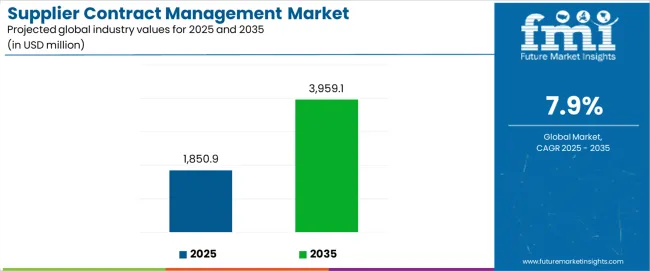
| Period | Primary Revenue Buckets | Share | Notes |
|---|---|---|---|
| Today | Cloud-based contract management platforms | 58% | SaaS deployment, enterprise adoption |
| On-premises contract solutions | 28% | Traditional deployment, security-focused | |
| Hybrid deployment models | 14% | Mixed environments, gradual migration | |
| Future (3-5 yrs) | Advanced cloud platforms | 65-68% | ai integration, predictive analytics |
| Large enterprise solutions | 32-35% | Complex procurement, multi-vendor management | |
| SME-focused platforms | 18-22% | simplified deployment, cost-effective | |
| Industry-specific solutions | 12-16% | Manufacturing, healthcare, financial services | |
| Integration & consulting services | 8-12% | Implementation support, customization | |
| Advanced analytics modules | 6-10% | Risk assessment, performance optimization |
| Metric | Value |
|---|---|
| Market Value (2025) | USD 1,850.9 million |
| Market Forecast (2035) | USD 3,959.1 million |
| Growth Rate | 7.9% CAGR |
| Leading Deployment | Cloud-based Solutions |
| Primary Customer | Large Enterprises Segment |
The supplier contract management market demonstrates strong fundamentals with cloud-based contract management systems capturing a dominant share through advanced platform capabilities and enterprise application optimization. Large enterprise applications drive primary demand, supported by increasing procurement complexity and supply chain digitization initiatives. Geographic expansion remains concentrated in developed markets with established enterprise infrastructure, while emerging economies show accelerating adoption rates driven by digital transformation initiatives and rising procurement efficiency standards.
Design for enterprise scalability, not just functionality
Primary Classification: The market segments by deployment type into cloud-based, on-premises, and hybrid solutions, representing the evolution from traditional installed software to sophisticated cloud-native platforms for comprehensive contract management optimization.
Secondary Classification: Application segmentation divides the supplier contract management market into large enterprises, small and medium enterprises (SMEs), and government organizations, reflecting distinct requirements for contract complexity, compliance standards, and procurement volume specifications.
Tertiary Classification: End-use segmentation covers manufacturing, healthcare, financial services, retail, technology, and energy sectors, while distribution channels span direct sales, system integrators, and specialized procurement consultants.
Regional Classification: Geographic distribution covers North America, Latin America, Western Europe, Eastern Europe, East Asia, South Asia Pacific, and Middle East & Africa, with developed markets leading adoption while emerging economies show accelerating growth patterns driven by procurement digitization programs.
The segmentation structure reveals deployment progression from traditional on-premises installations toward sophisticated cloud-based platforms with enhanced integration capabilities, while application diversity spans from large-scale enterprise implementations to specialized sector-specific solutions requiring precise contract management capabilities.
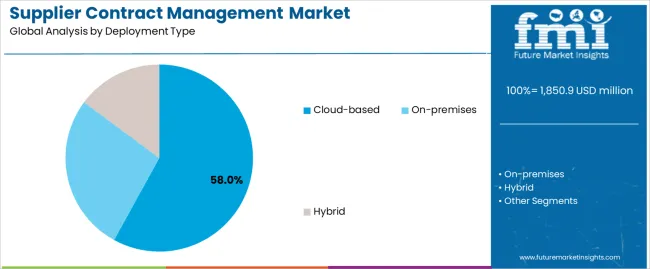
Market Position: Cloud-based contract management systems command the leading position in the supplier contract management market with 58% market share through proven platform technologies, including scalable architecture, real-time collaboration capabilities, and enterprise integration optimization that enable procurement organizations to achieve optimal contract oversight across diverse supplier and vendor environments.
Value Drivers: The segment benefits from enterprise preference for scalable contract management platforms that provide rapid deployment, automatic updates, and operational efficiency without requiring on-premises infrastructure. Advanced cloud processing features enable enhanced contract analytics, automated compliance monitoring, and integration with existing procurement systems, where performance visibility and contract intelligence represent critical operational requirements.
Competitive Advantages: Cloud-based contract management systems differentiate through proven scalability reliability, automatic platform updates, and integration with established enterprise resource planning systems that enhance procurement effectiveness while maintaining optimal compliance standards suitable for diverse organizational applications.
Key market characteristics:
On-premises contract management systems maintain a 28% market position in the supplier contract management market due to their security advantages and data control positioning benefits. These deployments appeal to organizations requiring strict data governance with enhanced security profiles for high-compliance operations. Market growth is driven by financial services expansion, emphasizing security-focused solutions and operational control through optimized governance designs.
Hybrid contract management deployments capture 14% market share through balanced approach combining cloud scalability with on-premises control, appealing to organizations transitioning from traditional systems while maintaining security requirements for sensitive contract data.
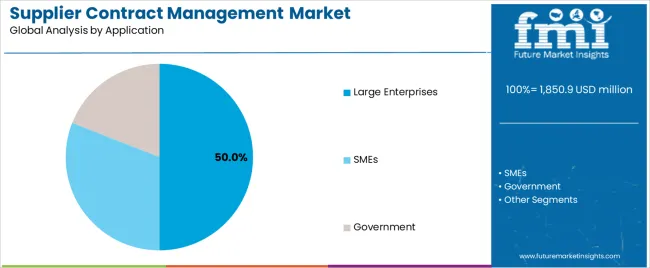
Market Context: Large enterprise applications demonstrate strong growth in the supplier contract management market with 8.2% CAGR due to widespread adoption of comprehensive contract governance programs and increasing focus on procurement excellence, operational cost efficiency, and supplier relationship applications that maximize contract effectiveness while maintaining compliance standards.
Appeal Factors: Large enterprise operators prioritize contract reliability, procurement consistency, and integration with existing enterprise infrastructure that enables coordinated contract operations across multiple business departments. The segment benefits from substantial digital transformation investment and modernization programs that emphasize the acquisition of advanced contract management capabilities for procurement optimization and risk mitigation applications.
Growth Drivers: Enterprise expansion programs incorporate contract management platforms as essential components for procurement operations, while supply chain complexity increases demand for contract capabilities that comply with regulatory standards and minimize operational complexity.
Market Challenges: Varying departmental requirements and operational scale complexity may limit contract standardization across different business units or procurement scenarios.
Application dynamics include:
Small and medium enterprise applications capture 38% market share through simplified deployment requirements in growing businesses, startup organizations, and operational applications. These organizations demand cost-effective contracts capable of supporting business requirements while providing procurement oversight access and operational efficiency capabilities.
Government applications account for emerging market share, including public sector organizations, regulatory agencies, and compliance-focused operations requiring specialized contract capabilities for transparency optimization and regulatory effectiveness.
Market Context: The Manufacturing sector dominates the supplier contract management market with a 7.8% CAGR, reflecting the primary demand source for supplier contract management technology in production applications and supply chain optimization.
Business Model Advantages: Manufacturing organizations provide direct market demand for comprehensive contract systems, driving volume adoption and cost optimization while maintaining quality control and supplier relationship requirements.
Operational Benefits: Manufacturing sector applications include supply chain optimization, cost efficiency, and quality assurance that drive consistent demand for contract systems while providing access to latest procurement technologies.
| Category | Factor | Impact | Why It Matters |
|---|---|---|---|
| Driver | Digital transformation & procurement modernization (cloud adoption, automation trends) | ★★★★★ | Growing enterprise market requires contract management platforms with enhanced procurement capabilities and automation properties proven effective across business applications. |
| Driver | Regulatory compliance advancement & risk management requirements (audit trails, governance standards) | ★★★★★ | Transforms contract requirements from "basic document storage" to "intelligent compliance management"; organizations that offer advanced compliance features and risk monitoring capabilities gain competitive advantage. |
| Driver | Supply chain complexity growth & vendor management (global sourcing, multi-tier suppliers) | ★★★★☆ | Complex organizations need sophisticated, scalable contract platforms; demand for comprehensive and intelligent contract solutions expanding addressable market. |
| Restraint | Implementation complexity & integration challenges (especially for legacy systems) | ★★★★☆ | Smaller organizations defer platform upgrades; increases implementation sensitivity and slows advanced contract adoption in resource-constrained markets. |
| Restraint | Data security concerns & compliance requirements (privacy regulations, data sovereignty) | ★★★☆☆ | Traditional security approaches offer established control mechanisms and compliance certainty, potentially limiting cloud-based contract adoption in security-conscious applications. |
| Trend | ai integration & intelligent automation (contract analytics, risk prediction) | ★★★★★ | Advanced AI capabilities, predictive analytics, and automation features transform operations; intelligence integration and performance enhancement become core value propositions. |
| Trend | Mobile accessibility & remote collaboration (mobile apps, digital signatures) | ★★★★☆ | Mobile-enabled contracts for distributed teams and remote applications; specialized mobility and collaboration capabilities drive competition toward accessibility solutions. |
The supplier contract management market demonstrates varied regional dynamics with Growth Leaders including China (10.7% growth rate) and India (9.9% growth rate) driving expansion through digital transformation initiatives and procurement modernization programs. Steady Performers encompass Germany (9.1% growth rate), Brazil (8.3% growth rate), and developed regions, benefiting from established enterprise infrastructure and contract management adoption. Mature Markets feature United States (7.5% growth rate), United Kingdom (6.7% growth rate), and Japan (5.9% growth rate), where procurement advancement and regulatory compliance requirements support consistent growth patterns.
Regional synthesis reveals East Asian markets leading adoption through enterprise digitization and procurement development, while North American countries maintain steady expansion supported by contract technology advancement and compliance standardization requirements. European markets show strong growth driven by regulatory applications and enterprise integration trends.
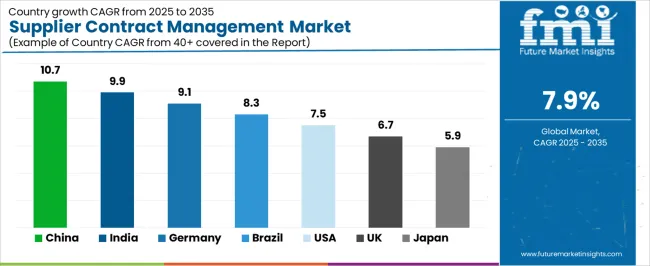
| Region/Country | 2025-2035 Growth | How to win | What to watch out |
|---|---|---|---|
| China | 10.7% | Focus on enterprise-scale solutions | Data localization requirements; local competition |
| India | 9.9% | Lead with cost-effective implementations | Infrastructure constraints; skills availability |
| Germany | 9.1% | Provide compliance-focused platforms | Regulatory complexity; data privacy requirements |
| Brazil | 8.3% | Offer localization-oriented solutions | Currency fluctuations; economic volatility |
| United States | 7.5% | Push AI integration capabilities | Competitive landscape; feature differentiation |
| United Kingdom | 6.7% | Focus on regulatory compliance | Brexit impacts; changing regulations |
| Japan | 5.9% | Emphasize quality and reliability | Traditional processes; change resistance |
China establishes fastest market growth through aggressive digital transformation programs and comprehensive procurement modernization initiatives, integrating advanced supplier contract management systems as standard components in enterprise facilities and manufacturing installations. The country's 10.7% growth rate reflects government initiatives promoting digital infrastructure and domestic contract management capabilities that mandate the use of intelligent contract systems in enterprise and manufacturing facilities. Growth concentrates in major business hubs, including Beijing, Shanghai, and Shenzhen, where enterprise development showcases integrated contract systems that appeal to procurement operators seeking contract optimization capabilities and operational applications.
Chinese enterprises are developing scalable contract solutions that combine domestic development advantages with advanced AI features, including enhanced analytics control and improved automation capabilities. Distribution channels through technology suppliers and enterprise consultants expand market access, while government support for digital transformation supports adoption across diverse manufacturing and enterprise segments.
Strategic Market Indicators:
In Mumbai, Delhi, and Bangalore, enterprise facilities and procurement organizations are implementing supplier contract management systems as standard equipment for procurement optimization and operational efficiency applications, driven by increasing government digitization investment and business modernization programs that emphasize the importance of contract intelligence capabilities. The supplier contract management market holds a 9.9% growth rate, supported by government digital initiatives and business development programs that promote intelligent contract systems for enterprise and manufacturing facilities. Indian operators are adopting contract systems that provide consistent procurement efficiency and automation features, particularly appealing in urban regions where contract optimization and operational excellence represent critical business requirements.
Market expansion benefits from growing enterprise capabilities and international business partnerships that enable domestic development of contract management systems for procurement and manufacturing applications. Technology adoption follows patterns established in enterprise software, where reliability and efficiency drive procurement decisions and operational deployment.
Market Intelligence Brief:
Germany's advanced enterprise market demonstrates sophisticated supplier contract management deployment with documented procurement effectiveness in manufacturing applications and enterprise facilities through integration with existing business systems and operational infrastructure. The country leverages engineering expertise in enterprise software and quality systems integration to maintain a 9.1% growth rate. Business centers, including Bavaria, Baden-Württemberg, and North Rhine-Westphalia, showcase premium installations where contract systems integrate with comprehensive enterprise platforms and facility management systems to optimize procurement effectiveness and operational efficiency.
German enterprises prioritize system quality and EU compliance in contract development, creating demand for premium systems with advanced features, including enterprise integration and procurement optimization systems. The supplier contract management market benefits from established enterprise infrastructure and a willingness to invest in contract management technologies that provide long-term operational benefits and compliance with international business standards.
Market Intelligence Brief:
Brazil's market expansion benefits from diverse enterprise demand, including business modernization in São Paulo and Rio de Janeiro, manufacturing facility upgrades, and government digitization programs that increasingly incorporate contract management solutions for procurement applications. The country maintains an 8.3% growth rate, driven by rising business activity and increasing recognition of contract management benefits, including precise procurement control and enhanced operational effectiveness.
Market dynamics focus on cost-effective contract solutions that balance procurement performance with affordability considerations important to Brazilian enterprise operators. Growing business industrialization creates continued demand for modern contract systems in new enterprise infrastructure and facility modernization projects.
Strategic Market Considerations:
United States establishes market leadership through comprehensive enterprise programs and advanced business infrastructure development, integrating supplier contract management systems across manufacturing and enterprise applications. The country's 7.5% growth rate reflects established enterprise industry relationships and mature contract technology adoption that supports widespread use of intelligent contract systems in manufacturing and enterprise facilities. Growth concentrates in major business centers, including California, New York, and Texas, where contract technology showcases mature deployment that appeals to procurement operators seeking proven contract capabilities and operational efficiency applications.
American enterprise providers leverage established distribution networks and comprehensive technical support capabilities, including implementation programs and training support that create customer relationships and operational advantages. The supplier contract management market benefits from mature regulatory standards and business requirements that support contract system use while encouraging technology advancement and operational optimization.
Market Intelligence Brief:
United Kingdom's enterprise market demonstrates integrated supplier contract management deployment with documented procurement effectiveness in manufacturing applications and enterprise facilities through integration with existing business systems and operational infrastructure. The country maintains a 6.7% growth rate, supported by business excellence programs and procurement effectiveness requirements that promote contract management systems for enterprise applications. Business facilities across England, Scotland, and Wales showcase systematic installations where contract systems integrate with comprehensive enterprise platforms to optimize procurement effectiveness and operational outcomes.
UK enterprise providers prioritize system reliability and industry compatibility in contract procurement, creating demand for validated systems with proven contract features, including compliance monitoring integration and procurement optimization systems. The supplier contract management market benefits from established enterprise infrastructure and excellence requirements that support contract technology adoption and operational effectiveness.
Market Intelligence Brief:
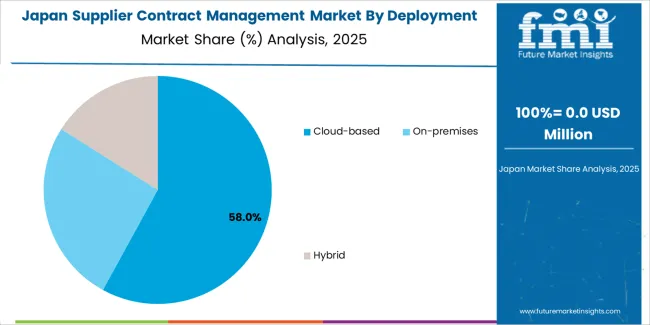
Japan's market growth benefits from precision enterprise demand, including advanced manufacturing facilities in Tokyo and Osaka, quality integration, and operational enhancement programs that increasingly incorporate contract solutions for procurement applications. The country maintains a 5.9% growth rate, driven by business technology advancement and increasing recognition of precision contract benefits, including accurate procurement control and enhanced operational outcomes.
Market dynamics focus on high-precision contract solutions that meet Japanese quality standards and procurement effectiveness requirements important to enterprise operators. Advanced business technology adoption creates continued demand for sophisticated contract systems in manufacturing facility infrastructure and operational modernization projects.
Strategic Market Considerations:
The European supplier contract management market is projected to grow from USD 412.7 million in 2025 to USD 882.1 million by 2035, registering a CAGR of 7.9% over the forecast period. Germany is expected to maintain its leadership position with a 41.3% market share in 2025, supported by its advanced enterprise infrastructure and major business centers.
United Kingdom follows with a 26.8% share in 2025, driven by comprehensive business programs and procurement excellence development initiatives. France holds a 15.2% share through specialized enterprise applications and regulatory compliance requirements. Italy commands a 9.7% share, while Spain accounts for 4.1% in 2025. The rest of Europe region is anticipated to gain momentum, expanding its collective share from 2.9% to 3.4% by 2035, attributed to increasing enterprise adoption in Nordic countries and emerging business facilities implementing procurement modernization programs.
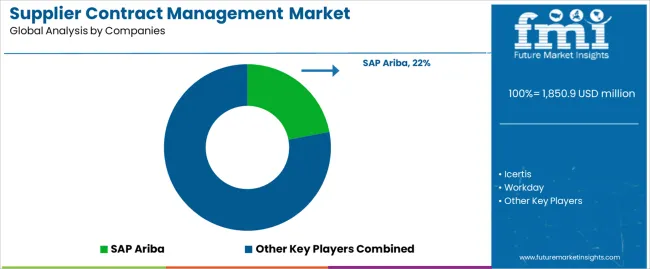
| Stakeholder | What they actually control | Typical strengths | Typical blind spots |
|---|---|---|---|
| Global platforms | Enterprise relationships, comprehensive feature sets, market presence | Wide availability, proven reliability, multi-region support | Innovation speed; customer dependency on platform evolution |
| Technology innovators | ai capabilities; advanced analytics; intelligent automation features | Latest technologies first; attractive ROI on contract intelligence | Service density outside core regions; scaling complexity |
| Regional specialists | Local compliance, fast deployment, nearby customer support | "Close to customer" support; pragmatic pricing; local regulations | Technology gaps; talent retention in customer service |
| Full-service providers | Implementation services, training programs, ongoing support | Lowest operational risk; comprehensive support | Service costs if overpromised; technology obsolescence |
| Niche specialists | Industry-specific features, custom workflows, specialized compliance | Win premium applications; flexible configurations | Scalability limitations; narrow market focus |
| Item | Value |
|---|---|
| Quantitative Units | USD 1,850.9 million |
| Deployment Type | Cloud-based, On-premises, Hybrid |
| Application | Large Enterprises, SMEs, Government |
| End Use | Manufacturing, Healthcare, Financial Services, Retail, Technology, Energy |
| Regions Covered | North America, Latin America, Western Europe, Eastern Europe, East Asia, South Asia Pacific, Middle East & Africa |
| Countries Covered | China, India, Germany, Brazil, United States, United Kingdom, Japan, Canada, France, Australia, and 25+ additional countries |
| Key Companies Profiled | SAP Ariba, Icertis, Workday, Adobe, Juro, top.legal, Authbridge, Manutan, DeepStream |
| Additional Attributes | Dollar sales by deployment type and application categories, regional adoption trends across East Asia, North America, and Western Europe, competitive landscape with software providers and system integrators, enterprise operator preferences for contract effectiveness and procurement optimization, integration with enterprise platforms and workflow management systems, innovations in AI technology and contract intelligence, and development of advanced contract solutions with enhanced automation and operational optimization capabilities. |
The global supplier contract management market is estimated to be valued at USD 1,850.9 million in 2025.
The market size for the supplier contract management market is projected to reach USD 3,959.1 million by 2035.
The supplier contract management market is expected to grow at a 7.9% CAGR between 2025 and 2035.
The key product types in supplier contract management market are cloud-based, on-premises and hybrid.
In terms of application, large enterprises segment to command 50.0% share in the supplier contract management market in 2025.






Full Research Suite comprises of:
Market outlook & trends analysis
Interviews & case studies
Strategic recommendations
Vendor profiles & capabilities analysis
5-year forecasts
8 regions and 60+ country-level data splits
Market segment data splits
12 months of continuous data updates
DELIVERED AS:
PDF EXCEL ONLINE
Analyzing Supplier Quality Management Applications Market Share
Supplier Quality Management Applications Market Outlook 2025 to 2035
UK Supplier Quality Management Applications Market Analysis – Demand, Trends & Forecast 2025-2035
USA Supplier Quality Management Applications Market Insights – Trends, Demand & Growth 2025-2035
Japan Supplier Quality Management Applications Market Trends – Size, Share & Outlook 2025-2035
Germany Supplier Quality Management Applications Market Trends – Growth, Share & Outlook 2025-2035
GCC Countries Supplier Quality Management Applications Market Growth – Demand, Trends & Forecast 2025-2035
Bird Feeding & Water Suppliers Market Trends – Growth & Forecast 2025 to 2035
Contract Logistics Market Size and Share Forecast Outlook 2025 to 2035
Contract Furniture Market Analysis by Product Type, End-users, Distribution Channel, and Region from 2025 to 2035.
Contractual Cleaning Services Market Growth - Trends & Forecast 2025 to 2035
Contract Packaging Market from 2025 to 2035
Contract Blending Services Market
Contract Dose Manufacturing Market
Contract Management Software Market Analysis By Solution, By Enterprise Size, By Business Function and Industry Through 2035
Contract Lifecycle Management Market Growth – Trends & Forecast 2025 to 2035
Global IVD Contract Manufacturing Market Trends – Size, Forecast & Growth 2024-2034
Blockchain-Powered Smart Contracts – Future of Legal Transactions
Biologics Contract Manufacturing Market Size and Share Forecast Outlook 2025 to 2035
Biosimilar Contract Manufacturing Market Size and Share Forecast Outlook 2025 to 2035

Thank you!
You will receive an email from our Business Development Manager. Please be sure to check your SPAM/JUNK folder too.
Chat With
MaRIA